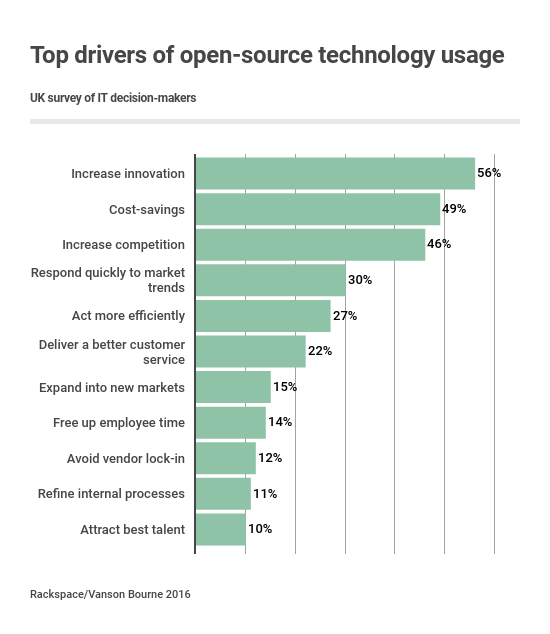Open-source computing and the cloud have brought many previously unaffordable IT options to small and medium-sized enterprises (SMEs). The same is becoming true of artificial intelligence (AI), although it brings new challenges to all sizes of company.
Even though many of the commercial, high-profile products are aimed at Global 2000 companies, and others marketed at SMEs are perhaps heavier on hype than intelligence, the smarter smaller organisations can learn, build on and use AI techniques right now, with those same open-source and cloud-scalable advantages.
AI strategy: identify a problem and find suitable data
The most important single benefit of open-source machine intelligence for SMEs is early experience in what’s important and how it works. Just don’t expect business benefits from the start.
“It’s possible to learn about AI with an open-source framework,” says Chris Nicholson, co-founder and chief executive of Skymind, makers of open-source AI software. “In practice, AI is hard. The software is free and you can rent the hardware for pennies an hour in the public cloud, but AI is data science and that has two problems – one is the data and the other is the science.”
All AI works through learning by example to find patterns in sets of data. For example, you might want to find which customer service staffer copes best with more demanding customers. If your customer relationship management data has this information – length of call, representative’s name, how often a customer calls – then that might be a good problem to work on. “You need to identify a problem,” says Mr Nicholson. “Then, ask yourself whether you have the data, whether it’s suitable.”
AI is data science and that has two problems – one is the data and the other is the science
Billy Wallace, knowledge exchange fellow at Strathclyde University, runs workshops introducing SMEs to AI. He points out that modern software can provide a lot of data for AI to feed on. “Apps running on mobile platforms and connected to the cloud can produce lots and lots of data, and lots and lots of opportunities for machine-learning,” he says.
Choosing the right framework and the right approach
Once you have your first AI-tractable problem, the next task is finding the right platform or framework to construct a solution on. A key insight is that existing IT talent within your organisation will already know about open-source AI, their depth of knowledge correlating more with personal aptitude than job title.
“If you have software engineers, they’ll know a lot of the nuts and bolts of putting things together,” says Mr Wallace. Most of the AI frameworks work with familiar languages – Python and Java are common – and TensorFlow is becoming a standard for building information flow within frameworks.
Choice of approach is next. There is no one AI technique, no one machine-learning algorithm, which is automatically appropriate. “You need to hire the talent to choose the algorithms”, says Mr Nicholson, “That’s difficult.” Mr Wallace agrees: “Data scientists are like hens’ teeth. You can outsource the expertise, but there’s a lot of hype to deal with.” However, SMEs may not be at much of a disadvantage. “Even Fortune 500 companies are finding this hard,” says Mr Nicholson.
The right dataset has to be selected, cleaned and formatted for training the AI. The most appropriate algorithms and mechanisms have to be chosen. The results of the learning phase have to be understood, and the quality of the AI’s output on live data properly assessed.
Make full use of national AI training
Modern frameworks make trying different approaches easier, but they can’t yet replace a good grounding in data science. Some claim to automate algorithm selection and training but, says Mr Nicholson, this just doesn’t work. “There may be a couple of small steps out of many that can perhaps be automated, but platforms that claim to replace data scientists in developing AI just cannot. It’s nonsense.”
If you can’t buy it in or farm it out, then leaning about AI means making full use of the physical and online communities which have evolved. Mr Wallace points out that there are many government training and incubator schemes, as AI skills are now seen as being of national importance. Moreover, cities with software developer communities normally have regular specialist public access meetups. “You’ll find 20 to 40 people working in AI. Someone there may already have worked on your problem,” he says.
There’s a plethora of online communities too, some based around particular services or frameworks, others more general, but places such as Quora or Stack Overflow serve as clearing houses for any question of any level of expertise and specificity. They are also superb guides to training materials. Once you’ve selected your preferred platform and approach, you’ll soon find where the best community support is.
SMEs should be aware of how AI works and what it can do
AI won’t be plug and play for SME developers for a long time, but effort gaining skills will be rewarded. “It’s important for SMEs to keep an eye on AI. There’s a lot of hype, but it is genuinely disruptive, with the potential for your little space in your business world to disappear.” says Mr Wallace. “Don’t panic, but you should be aware of how AI works and what it can do.”
SMEs shouldn’t expect open-source AI means a free path to business gains. But it is a path to giving you and your organisation the experience to look coolly at AI as it develops over the next few years, using it to your best advantage and on your own terms.
AI strategy: identify a problem and find suitable data
Choosing the right framework and the right approach

